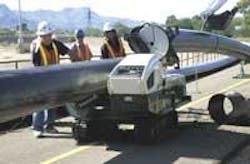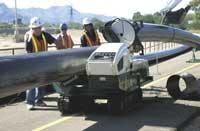National Security Report Outlines Strategy to Protect Infrastructure
The US water industry has taken great strides to protect its critical facilities and systems but much work still needs to be done, according to a recently released National Strategy for the Physical Protection of Critical Infrastructures and Key Assets.
The strategy document, released by the White House in February, spells out a national policy and guiding principles for a variety of critical industries and systems, including water, agriculture and food, public health, emergency services, the defense industry, telecommunications, energy, transportation and more.
According to the document, the nation's water sector is critical from both a public health and an economic standpoint.
"The water sector consists of two basic, yet vital, components: fresh water supply and wastewater collection and treatment," the report stated. "Sector infrastructures are diverse, complex, and distributed, ranging from systems that serve a few customers to those that serve millions.
"On the supply side, the primary focus of critical infrastructure protection efforts is the nation's 170,000 public water systems. These utilities depend on reservoirs, dams, wells, and aquifers, as well as treatment facilities, pumping stations, aqueducts, and transmission pipelines. The wastewater industry's emphasis is on the 19,500 municipal sanitary sewer systems, including an estimated 800,000 miles of sewer lines."
Examples of the steps taken by the water sector to protect its critical facilities and systems include developing vulnerability assessment methodologies for both drinking water and wastewater facilities. To improve the flow of information among water-sector organizations, the industry also has begun development of a water sector ISAC (Information Sharing & Analysis Center). The Water ISAC will provide a secure forum for gathering, analyzing, and sharing security related information. Additionally, several federal agencies are working together to improve the warehousing of information regarding contamination threats, such as the release of biological, chemical, and radiological substances into the water supply, and how to respond to their presence in drinking water.
With respect to identifying new technologies, the EPA has an existing program that develops testing protocols and verifies the performance of innovative technologies. It has also initiated a new program to verify monitoring technologies that may be useful in detecting or avoiding biological or chemical threats.
The following is information taken directly from the Strategy report dealing with the water industry:
Water Sector Challenges
The basic human need for water and the concern for maintaining a safe water supply are driving factors for water infrastructure protection. Public perception regarding the safety of the nation's water supply is also significant, as is the safety of people who reside or work near water facilities. In order to set priorities among the wide range of protective measures that should be taken, the water sector is focusing on the types of infrastructure attacks that could result in significant human casualties and property damage or widespread economic consequences.
In general, there are four areas of primary concentration:
• Physical damage or destruction of critical assets, including intentional release of toxic chemicals;
• Actual or threatened contamination of the water supply;
• Cyber attack on information management systems or other electronic systems; and
• Interruption of services from another infrastructure.
To address these potential threats, the sector requires additional focused threat information in order to direct investments toward enhancement of corresponding protective measures. The water sector also requires increased monitoring and analytic capabilities to enhance detection of biological, chemical, or radiological contaminants that could be intentionally introduced into the water supply.
Some enterprises are already developing monitoring and sampling technologies, but additional resources from the water sector will likely be needed. Environmental monitoring techniques and technologies and appropriate laboratory capabilities require enhancement to provide adequate and timely analysis of water samples to ensure early warning capabilities and assess the effectiveness of clean-up activities should an incident occur. Specific innovations needed include new broad spectrum analytical methods, monitoring strategies, sampling protocols, and training.
Approaches to emergency response and the handling of security incidents at water facilities vary according to state and local policies and procedures.
With regard to the public reaction associated with contamination or perceived contamination, it is essential that local, state, and federal departments and agencies coordinate their protection and response efforts. Maintaining the public's confidence regarding information provided and the timeliness of the message is critical. Suspected events concerning water systems to date have elicited strong responses that involved taking systems out of service until their integrity could be verified, announcing the incident to the public, and issuing "boil water" orders.
The operations of the water sector depend extensively on other sectors. The heaviest dependence is on the energy sector. For example, running pumps to move water and wastewater and operating drinking water and wastewater treatment plants require large amounts of electricity. To a lesser extent, the water sector also depends on the transportation system for supplies of water treatment chemicals, on natural gas pipelines for the energy used in some operational activities, and on the telecommunications sector. Water and wastewater systems are increasingly automated and controlled from remote locations for efficiency.
Water Sector Initiatives
Water infrastructure protection initiatives are guided both by the challenges that the water sector faces and by recent legislation. Additional protection initiatives include efforts to:
Identify high-priority vulnerabilities and improve site security — EPA, in concert with the Department of Homeland Security (DHS), state and local governments, and other water sector leaders, will work to identify processes and technologies to better secure key points of storage and distribution, such as dams, pumping stations, chemical storage facilities, and treatment plants. EPA and DHS will also continue to provide tools, training, technical assistance, and limited financial assistance for research on vulnerability-assessment methodologies and risk-management strategies.
Improve sector monitoring and analytic capabilities — EPA will continue to work with sector representatives and other federal agencies to improve information on contaminants of concern and to develop appropriate monitoring and analytical technologies and capabilities.
Improve sector-wide information exchange and coordinate contingency planning — DHS and EPA will continue to work with the sector coordinator and the water ISAC to coordinate timely information on threats, incidents, and other topics of special interest to the water sector. DHS and EPA will also work with the sector and the states to standardize and coordinate emergency response efforts and communications protocols.
Work with other sectors to manage unique risks resulting from interdependencies — DHS and EPA will convene cross-sector working groups to develop models for integrating priorities and emergency response plans in the context of interdependencies between the water sector and other critical infrastructures.

